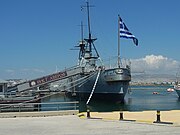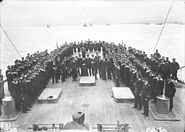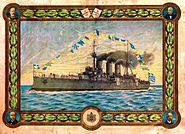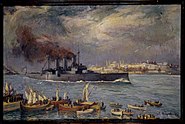Coordinates: 37°56′02″N 23°41′01″E / 37.93389°N 23.68361°E
| Greek cruiser Georgios Averof | |
|---|---|
 Averof as a floating museum in Palaio Faliro, Athens | |
| Career | |
| Name: |
|
| Namesake: | George Averoff |
| Ordered: | 1909 |
| Builder: | Cantiere navale fratelli Orlando, Livorno |
| Laid down: | 27 February 1910 |
| Launched: | 12 March 1910 |
| Commissioned: | 16 May 1911 |
| Decommissioned: | 1 August 1952 |
| Nickname: | "Lucky Uncle George" by Greeks, "Seitan papor" by Turks |
| Fate: | Used as museum ship |
| Status: | Museum ship at Palaio Faliro |
| Notes: |
|
| General characteristics | |
| Class & type: | Pisa-class armored cruiser |
| Displacement: |
|
| Length: | 140.13 m (459.7 ft) |
| Beam: | 21 m (69 ft) |
| Draft: | 7.18 m (23.6 ft) |
| Propulsion: | Boilers: 22× Belleville water tube type, Engines: 2× four-cylinder compound reciprocating steam engines, Shafts: twin screw ship, Power: 19,000 shp (14.2 MW) |
| Speed: |
|
| Range: | 2,480 nautical miles (4,590 km) at 17.5 knots (32 km/h) |
| Complement: |
|
| Armament: |
|
| Armor: |
|
Georgios Averof (Greek: Θ/Κ Γεώργιος Αβέρωφ) is a modified Pisa-class armored cruiser built in Italy for the Royal Hellenic Navy in the first decade of the 20th century. The ship served as the Greek flagship during most of the first half of the century. Although popularly known as a battleship (θωρηκτό) in Greek, she is in fact an armored cruiser (θωρακισμένο καταδρομικό),[1] the only ship of this type still in existence.
History[]
Construction and arrival in Greece[]

Right elevation and plan drawing of Georgios Averof from Brassey's Naval Annual 1915
At the beginning of the 20th century, Greece decided to reinforce its fleet, whose ships were fast becoming obsolete due to the rapidly advancing naval technology of the era. The navy procured eight destroyers (then a relatively new type of ship) between 1905-1907, but the most important addition was Averof. The ship, a Pisa-class cruiser like her Italian sisters Amalfi and Pisa, was being built at Orlando Shipyards at Livorno in Italy. When the Italian government cancelled the third ship of the class due to budgetary concerns, the Greek government immediately stepped in and bought her with a one-third downpayment (ca. 300,000 gold pound sterling), paid with the help of a wealthy Greek benefactor, George Averoff, whose name she consequently received.
The ship was fitted with a combination of Italian engines, French boilers, British artillery and German generators.[2] Such was the earnestness of the Greek Navy to acquire and put her into service that she was delivered with a known deficiency in the barrel of one of her 7.5 inch guns (a gouge in the barrel produced by a slipping of the rifling cutting tool), and hastily accepted for service on the opinion of Armstrong Whitworth's chief ordnance engineer (a totally informed opinion, as it turned out), who judged the defect as inconsequential to the gun's safety and performance.
The ship was launched on 12 March 1910. Her first captain was Captain Ioannis Damianos, who took command of her on 16 May 1911. Averof sailed for Britain, in order to participate in the festivities for the coronation of King George V and to receive her first load of ammunition. The stay in Britain was troubled, however, including running aground at Spithead on 19 June, forcing her to be drydocked for repairs, brawls with locals and a near-mutiny resulting from the unfamiliarity of the Greek sailors with blue cheese. It was clear that Captain Damianos was inadequate, so he was replaced by the highly esteemed Captain Pavlos Kountouriotis, who quickly reimposed discipline and set sail for Greece. During the journey, Kountouriotis took care to train the crew, with the notable exception of gunnery practice, since ammunition was limited. Averof finally sailed into Faliro Bay, near Athens, on 1 September 1911. Averof was at the time the most modern and powerful ship in the navies of either the Balkan League or the Ottoman Empire.
The Balkan Wars[]
With the outbreak of the First Balkan War in October 1912, Kountouriotis was named Rear Admiral and Commander-in-Chief of the Hellenic Royal Navy. Averof, under Captain Sofoklis Dousmanis, served as the flagship of the fleet, and she took part in the takeover of the islands of the northern and eastern Aegean. During the naval battles at Elli (3 December 1912) and Lemnos (5 January 1913) against the Ottoman Navy, she almost single-handedly secured victory and the undisputed control of the Aegean Sea for Greece. In both battles, due to her superior speed, armor and armament, she left the battle line and pursued the Turkish Fleet alone. During the Battle of Elli, Kountouriotis, frustrated by the slow speed of the three older Greek battleships, hoisted the Flag Signal for the letter Z which stood for "Independent Action", and sailed forward alone, with a speed of 20 knots against the Turkish fleet. Averof succeeded in crossing the Turkish fleet's "T" and concentrated her fire against the Ottoman flagship, thus forcing the Ottoman fleet to retreat in disorder. Likewise, during the Battle of Lemnos, when the older battleships failed to follow up with Averof, Kountouriotis did not hesitate to pursue independent action.
In each battle the ship suffered only slight damage, while inflicting severe damage to several Turkish ships. These exploits propelled her and her Admiral to legendary status in Greece. After Lemnos, the crew of the Averof affectionately nicknamed her "Lucky Uncle George". It is a notable fact that, due to the aforementioned delays in the delivery of ammunition, Averof fired her guns for the first time during the Battle of Elli.
Georgios Averof is credited with successfully closing the Aegean Sea to Ottoman transports bringing fresh troops and supplies to the front during the First Balkan War. This success had a concrete impact on the land action where the Ottoman forces suffered decisive defeats. It is hypothesized that in the lack of such decisive control of the sea by the Greek Navy, the Ottoman Empire might have reinforced its forces on the Balkan Peninsula and therefore fared better in the war.[3]
World Wars and aftermath[]
During World War I, Averof did not see much active service, as Greece was neutral during the first years of the war, and in deep internal turmoil (see National Schism). After the Noemvriana riots of 1916, she was seized by the French, and returned only after Greece's formal entry in the war in June 1917. After the war's end, Averof sailed with other Allied ships to Constantinople, receiving an ecstatic welcome from the city's Greeks. She continued as the flagship of the RHN under Rear Admiral I. Ipitis, participating in landings in Eastern Thrace and bombardments of the Turkish Black Sea shore during the Greco-Turkish War (1919–22) and helped in the evacuation of the refugees after the Greek Army's defeat. In 1925-27 she underwent major reconstruction in France, in which she received modern anti-aircraft armament, a new foremast and improved fire control equipment, while the obsolete torpedo tubes were removed.

A naval band plays under Averof's main guns, shortly before celebrating Independence Day during World War II.
After Germany's attack against Greece in 1941 and the collapse of the front, the ship's crew disobeyed the orders to scuttle her to avoid capture by the Germans, and sailed to Souda Bay, Crete, under the constant threat of German air strikes (which had sunk many Greek and British warships in the evacuation of Greece). Her Commanding Officer embarked from a rope ladder when she was already underway.
From Souda Bay she sailed to Alexandria, arriving there on 23 April. From August 1941 to the end of 1942 she was assigned to convoy escort and patrol duties in the Indian Ocean, based at Bombay. After that, she was anchored at Port Said. On 17 October 1944, once again as the flagship of the exiled Hellenic Navy, under the command Captain Theodoros Koundouriotis (the Admiral's son), she carried the Greek government-in-exile back to liberated Athens. She continued as Fleet Headquarters until she was decommissioned in 1952. She remained anchored at Salamis until she was towed to Poros, where she remained from 1956 to 1983.
Averof as a floating museum[]
In 1984 the Navy decided to restore her as a museum, and in the same year she was towed to Palaio Faliro, where she is anchored as a functioning floating museum, seeking to promote the historical consolidation and upkeep of the Greek naval tradition. Free guided tours are provided to visiting schools and on holidays. She is berthed at Trocadero quay, next to Faliro Marina and the Resteion swimming pool and park.

Georgios Averof with gangway in place for visitors in 2013
The ship is regarded as in active service, carrying the Rear Admiral's Rank Flag a square blue flag with white cross, like the Greek jack, with two white stars in each of the two squares on the flagstaff side (see photo at right, also see[4] and[5]) atop the mainmast with the Masthead Pennant (a long triangular blue flag with a white orthogonal Greek cross) displaced downward. Every Hellenic Navy ship entering or sailing in Faliro Bay honours the Averof while passing. The crew are ordered to attention (with the "Still to" order) and from the relevant Boatswain's pipe (or bugle call) every man on decks stands to attention, officers saluting, looking to the side where the Averof is in sight until "Continue" is ordered (this link is an mp3 sound recording of the order in Greek "Still to port side", the boatswain's pipe call and the order "Continue").
In June 2010 the ship was involved in a scandal after being used as the stage for a lavish wedding party by Greek shipowner Leo Patitsas and TV persona Marietta Chrousala. The publication of photos from the party by the Proto Thema tabloid caused major political uproar, resulting in the dismissal of her commander, Commodore Evangelos Gavalas.[6][7]
Image gallery[]
References[]
- ↑ However she was usually classified as a battlecruiser after the Washington Naval Treaty (1922) because her displacement and main armament slightly exceeded the limits imposed on cruisers.
- ↑ http://www.bsaverof.com
- ↑ Ozturk, Cagri., "For Want of a Horseshoe: Alternate Histories of Turkey That Fared Better in the First Balkan War", paper presented at The Centenary of the Balkan Wars (1912-1913): Contested Stances Conference, 23–24 May 2013, Middle East Technical University, Ankara.
- ↑ http://www.hnsa.org/ships/averoff.htm
- ↑ http://www.pbase.com/drf/image/22944735
- ↑ "Error: no
|title=specified when using {{Cite web}}" (in Greek). AlphaTV. http://www.alphatv.gr/index.asp?a_id=90&news_id=42012. Retrieved 2010-08-17. - ↑ "Error: no
|title=specified when using {{Cite web}}" (in Greek). Naftemporiki. http://www.naftemporiki.gr/news/cstory.asp?id=1830048. Retrieved 2010-08-17.
External links[]
| Wikimedia Commons has media related to Category:Georgios Averof (ship, 1910). |
- Georgios Averof Museum Web Page
- HNSA Web Page: Hellenic cruiser Averof
- Photographic tour of the ship
- Relevant U boat Net page
- Photo gallery
- "G. Averof" March in mp3 from the Greek Navy's web page
| ||||||||
The original article can be found at Greek cruiser Georgios Averof and the edit history here.



